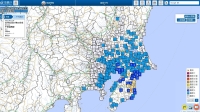A series of earthquakes that has rattled the eastern coast of Chiba Prefecture and surrounding areas over the past week — believed to be part of a phenomenon known as a “slow slip” in tectonic plates — have prompted a government panel to warn of more “strong tremors” in the coming days.
Three earthquakes measuring a shindo 4 on the Japanese seismic intensity scale, as well as four measuring a shindo 3, have occurred since Thursday, including a magnitude 5.2 quake on Friday.
These quakes are believed to have been caused by a slow slip between the Philippine Sea plate and the continental plate off the Chiba coast, based on satellite data from Japan’s Geospatial Information Authority.
While a regular earthquake is a quick slip, a slow one can cause little shaking on the surface. Slow slips occur when strains build up to the limits just as with ordinary earthquakes but the slides are slow due to fault properties, with a repeated cycle of locking and slow slipping.
Similar seismic activity has been observed at various intervals in recent years — including in 1996, 2002, 2007, 2011, 2014 and 2018 — with the activity lasting anywhere from a week to several months.
In 2018, around a month after a slow slip event occurred, a magnitude 6.0 earthquake that registered a lower 5 on the shindo scale hit Chiba Prefecture.
The Meteorological Agency is urging people in the area to be vigilant of future seismic activity.
As of Thursday, the largest slip movement was measured at around 2 centimeters off the coast of Chiba’s Boso Peninsula.
Under the Japanese archipelago — one of the world’s most tectonically active spots — four continental and oceanic plates overlap, with the oceanic plates sinking beneath the continental plates. When the accumulated strain near the boundary between the two reaches its limit, the fault slips at a high speed of around a meter per second, causing shaking on land and potentially generating tsunami. In contrast, slow slip events involve the gradual movement of the boundary or fault over a period of several days to several years.
But residents and visitors in the area are still being asked to maintain vigilance in case of strong quakes — especially as government data puts the probability of a major earthquake of a magnitude 7 hitting the southern Kanto region at 70% within the next 30 years.
Fumihiko Imamura, a professor at Tohoku University’s International Research Institute of Disaster Science, said that as Japan experiences a variety of natural disasters, people should go about their daily lives as usual, but remain prepared, including by having a knowledge of their municipality’s hazard maps, which show where disasters such as quakes and floods may strike, as well as the locations of nearby evacuation centers.
As the Noto Peninsula continues with its recovery efforts, Imamura believes that these are chances for Japan to learn and build far stronger communities.
“Fostering a culture of disaster preparedness is crucial,” he says. “It’s important to prioritize safety when disaster strikes, but it’s also very important to create new cultures from these lessons.”





















With your current subscription plan you can comment on stories. However, before writing your first comment, please create a display name in the Profile section of your subscriber account page.